Topical Steroid Use While on HIV Therapy May Lead to Cushing’s, Case Study Shows

Using steroid-based creams to treat skin conditions in the genital area may lead to the fast development of medication-related Cushing’s syndrome in adults with HIV on antiretroviral therapy with Norvir (ritonavir), a case report shows.
A combination of higher steroid absorption in the genital mucosa (in this case, the inner surface of the foreskin) and less effective degradation due to an interaction with Norvir may explain this rare case of Cushing’s syndrome after one month of moderate-potency topical steroid use, the researchers said.
However, they noted that these findings highlight the need for increased awareness among physicians and patients about the interaction of Norvir with steroids.
The case study, “Rapid Development of Iatrogenic Cushing’s Syndrome in a Patient on Ritonavir: the Adverse Metabolic Consequence of Topical Steroid Use,” was published in the journal AACE Clinical Case Reports.
Exogenous Cushing’s syndrome, or medication-related disease, is caused by abnormally high levels of the hormone cortisol in the body following prolonged exposure to cortisol-like steroid medications.
High steroid levels can make the body believe there is enough cortisol, lowering its production by the adrenal glands. Prolonged steroid exposure also can impair how the adrenal glands respond to signals to produce cortisol, leading to adrenal insufficiency.
Norvir, an antiretroviral therapy marketed by AbbVie, is commonly used in combination with other such medications to manage HIV infection. It is a potent suppressor of the cytochrome P450 enzyme pathway, which is involved in several viral processes, but also in the breakdown of steroids.
Therefore, combining Norvir with steroids may result in medication interactions. Such interactions can impair steroid degradation and ultimately lead to exogenous Cushing’s syndrome. Medication-related Cushing’s syndrome has been reported in HIV patients on Norvir following the use of steroids administered through injections or inhalations.
However, to date, “there have been no reported cases of [exogenous] Cushing’s syndrome resulting from the use of mid-potency topical steroids in adult patients with HIV on [Norvir],” the researchers wrote.
Of note, the skin’s natural structure usually acts as a barrier to excessive steroids, preventing their absorption and spread throughout the body.
Now, researchers at the University of Texas Medical Branch have reported the case of a 41-year-old man with HIV on stable antiretroviral therapy that included Norvir who developed Cushing’s syndrome after applying a moderate-potency topical steroid cream, triamcinolone, on his genital area for one month.
The man, with a history of well-controlled HIV infection, was admitted to the hospital after being found to have diabetes in a routine clinic follow-up. He reported increased thirst and urination, blurry vision, and easy bruising for the past month, consistent with diabetes.
Further examination revealed common signs of Cushing’s syndrome, such as facial redness, increased fat above the collarbone and between the shoulders, and purple stretch marks in the abdomen.
He reported no known history of steroid use. A midnight salivary test showed excessive cortisol levels, while a 24-hour urine analysis and a morning blood draw showed undetectable or abnormally low cortisol levels, suggesting suppressed cortisol production.
The team noted that the salivary test, based on an antibody reaction, likely detected the presence of the synthetic steroid triamcinolone instead of cortisol, a known limitation of this type of test. Other assays are therefore recommended to distinguish cortisol from synthetic steroids in salivary samples.
Additional questioning revealed that the patient had been applying a cream with triamcinolone acetonide on the genital area to treat phimosis for a month prior to admission and during hospitalization. Phimosis is a condition in which the foreskin is too tight to be pulled back over the head of the penis (glans).
He would apply a fingertip amount of the cream twice daily between the glans and the internal surface of the foreskin. Until his consultation with the physicians, he was unaware that the cream was a topical steroid.
Besides exogenous Cushing’s syndrome, further testing showed that the patient had also developed adrenal insufficiency.
“It is possible that the application of triamcinolone to the genital mucosa in our patient … a body surface that is known to have higher systemic steroid absorption, may have likely contributed to enhance triamcinolone absorption, resulting in the rapid development of Cushing’s syndrome and the [suppression of] cortisol production,” the researchers wrote.
The man was instructed to discontinue topical steroid use and was placed on a particular steroid replacement therapy while waiting for his adrenal glands to regain normal function and cortisol production. His antiretroviral therapy regimen also was changed to avoid medication interactions.
“This case raises awareness on the severe metabolic consequence resulting from the seemingly benign use of a topical steroid medication when applied to the genital mucosa in the setting of stable therapy with [Norvir],” the team wrote.





